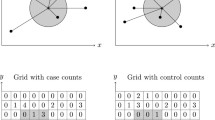Abstract
In this paper, we propose the details of algorithms for the echelon and the echelon scan techniques for the first time though we have already proposed these techniques through specific numerical examples in previous papers. We also release EcheScan software developed in R and Shiny-server based on this algorithm. Through an internet browser, researchers can access the technologies in web applications. We discuss the clustering and hotspot detection for spatial and temporal lattice data. Our approach is based on the idea of echelon techniques. The echelon dendrogram is a powerful tool to handle any types of lattice data with visualization. Regional features such as hotspots and trends are shown in an echelon dendrogram. The echelon scan technique searches for a hotspot by moving the scanning window in a particular manner. The echelon scan technique is easy to interpret based on regional hierarchical structure of interested values according to visual order. We propose the algorithms to obtain the elements for echelon and the maximum likelihood ratio based on echelon scan given the values of lattice and its neighbors. We also explain the usages of EcheScan software for echelon and echelon scanning. In addition, the echelon technique for two types of lattice data and spatio-temporal epidemiological lung cancer data in New Mexico are illustrated using EcheScan software.












Similar content being viewed by others
References
Cressie, N. (1993). Statistics for spatial data. New York: Wiley.
Cressie, N., & Chan, N. H. (1989). Spatial modelling of regional variables. Journal of the American Statistical Association, 84, 393–401.
Gelfand, A. E., Diggle, P. J., Fuentes, M., & Guttorp, P. (Eds.). (2010). Handbook of spatial statistics. Boca Raton: Chapman & Hall.
Huang, L., Kulldorff, M., & Gregorio, D. (2007). A spatial scan statistic for survival data. Biometrics, 63(1), 109–118.
Ishioka, F., & Kurihara, K. (2012). Detection of spatial clustering using echelon scan. In A. Colubi, (eds) Proceedings of the 20th international conference on computational statistics (COMPSTAT2012) (pp. 341–352). Heidelberg: Physica-Verlag.
Ishioka, F., Kawahara, J., Mizuta, M., Minato, S., & Kurihara, K. (2019). Evaluation of hotspot cluster detection using spatial scan statistic based on exact counting. Japanese Journal of Statistics and Data and Science, 2(1), 241–262.
Ishioka, F., Kurihara, K., Suito, H., Horikawa, Y., & Ono, Y. (2007). Detection of hotspots for 3-dimensional spatial data and its application to environmental pollution data. Journal of Environmental Science for Sustainable Society, 1, 15–24.
Kulldorff, M., & Harvard Medical School, Boston and Information Management Services Inc. (2018). SaTScan™v9.6: Software for the spatial and space-time scan statistics. http://www.satscan.org/. Accessed 1 July 2018.
Kulldorff, M. (1997). A spatial scan statistic. Communications in Statistics: Theory and Methods, 26(6), 1481–1496.
Kulldorff, M., Feuer, E. J., Miller, B. A., Athas, W. F., & Key, C. R. (1998). Evaluating cluster alarms: A space-time scan statistic and brain cancer in Los Alamos. American Journal of Public Health, 88, 1377–1380.
Kulldorff, M., Huang, L., & Konty, K. (2009). A scan statistic for continuous data based on the normal probability model. International Journal of Health Geographics, 8, 58.
Kulldorff, M., & Nagarwalla, N. (1995). Spatial disease clusters: Detection and inference. Statistics in Medicine, 14(8), 799–810.
Kurihara, K. (2003). The detection of hotspots based on the hierarchical spatial structure. Bulletin of the Computational Statistics of Japan, 15(2), 171–183.
Kurihara, K. (2004). Classification of geospatial lattice data and their graphical Representation. In D. Banks (Ed.), Classification, clustering, and data mining applications (pp. 251–258). Berlin: Springer.
Kurihara, K., Ishioka, F., & Moon, S. (2006). Detection of Hotspots on Spatial Data by Using Principal Component Analysis. Journal of the Korean Data Analysis Society, 8(2), 447–458.
Kurihara, K., Myers, W. L., & Patil, G. P. (2000). Echelon analysis of the relationship between population and land cover patterns based on remote sensing data. Community Ecology, 1, 103–122.
Myers, W. L., Kurihara, K., Patil, G. P., & Vraney, R. (2006). Finding upper level sets in cellular surface data using echelons and SaTScan. Environmental and Ecological Statistics, 13(4), 379–390.
Myers, W. M., Patil, G. P., & Joly, K. (1997). Echelon approach to areas of concern in synoptic regional monitoring. Environmental and Ecological Statistics, 4, 131–152.
Myers, W. M., Patil, G. P., & Taillie, C. (1999). Conceptualizing pattern analysis of spectral change relative to ecosystem status. Ecosystem Health, 5, 285–293.
Patil, G. P., & Taillie, C. (2004). Upper level set scan statistic for detecting arbitrarily shaped hotspots. Environmental and Ecological Statistics, 11(2), 183–197.
Takahashi, K., Yokoyama, T., & Tango, T. (2010). FleXScan v3.1.2: Software for the flexible scan statistic. Tokyo: National Institute of Public Health Japan.
Tango, T., & Takahashi, K. (2005). A flexible spatial scan statistic for detecting clusters. International Journal of Health Geographics, 4, 11.
Tango, T., & Takahashi, K. (2012). A flexible spatial scan statistic with a restricted likelihood ratio for detecting disease clusters. Statistics in Medicine, 31(30), 4207–4218.
Tomita, M., Hatsumichi, M., & Kurihara, K. (2008). Identify LD blocks based on hierarchical spatial data. Computational Statistics and Data Analysis, 52(4), 1806–1820.
Acknowledgements
The authors thank the Editor and the two referees for their sharp and constructive comments. This work was partly supported by JSPS KAKENHI Grant Number JP17K0005009.
Author information
Authors and Affiliations
Corresponding author
Additional information
Publisher's Note
Springer Nature remains neutral with regard to jurisdictional claims in published maps and institutional affiliations.
Appendices
Appendix 1: Input and output values of Algorithms 1–3
Appendix 2: Input and output files of EcheScan
See Tables 6.
Rights and permissions
About this article
Cite this article
Kurihara, K., Ishioka, F. & Kajinishi, S. Spatial and temporal clustering based on the echelon scan technique and software analysis. Jpn J Stat Data Sci 3, 313–332 (2020). https://doi.org/10.1007/s42081-020-00072-1
Received:
Accepted:
Published:
Issue Date:
DOI: https://doi.org/10.1007/s42081-020-00072-1




